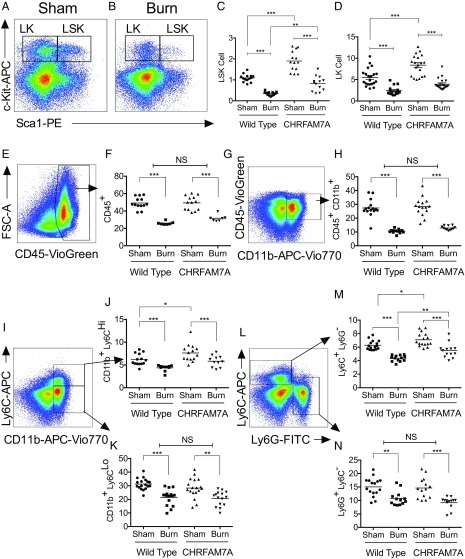Fig. 4.
CHRFAM7A spares bone marrow HSCs after burn with bias for monocyte lineage. (A and B) Flow cytometry analysis of mouse c-Kit+ Sca1+ lineage− hematopoietic stem cells after thermal injury. The gating strategy that separates LSK and LK hematopoietic progenitor populations in mouse bone marrow without (A) or after (B) a 4-h burn injury enables quantification of the LK (c-Kit+Sca1−) and LSK (c-Kit+Sca1+) percentage of cells gated out of the ∼10% lineage-negative staining cells. (C and D) Quantification of mouse hematopoietic LSK and LK stem cells in bone marrow of wild-type and CHRFAM7-transgenic mice. Quantification of LSK (C) and LK (D) hematopoietic progenitor populations from WT and CHRFAM7A mouse bone marrow after sham or a 4-h thermal injury. With no difference between C57BL/6 or siblings and transgenic line 3 or 4, data were combined for analyses by one-way ANOVA (**P < 0.01, ***P < 0.001). (E–N) Quantification of mouse myeloid cells in bone marrow after burn injury. After the exclusion of debris, doublets, and nonviable cells (SI Appendix, Fig. S10), resident myeloid cell subset lineages were assessed by flow cytometry in bone marrow without (sham) or with thermal injury (burn) in wild-type and CHRFAM7A-transgenic mice. Differences in immune cells including CD45+ leukocytes (E and F), CD45+CD11b+ monocytes (G and H), CD11b+Ly6CHigh/Low (I–K), and Ly6CHighLy6GLow and Ly6GHighLy6CLow (L and M) inflammatory, resident, and patrolling macrophages and granulocytes were calculated. With no observable differences between wild-type C57BL/6 siblings and commercial mice or between CHRFAM7A-transgenic lines 3 and 4, respectively (SI Appendix, Fig. S7), data were combined and differences were analyzed by one-way ANOVA (*P < 0.05, **P < 0.01, ***P < 0.001).

